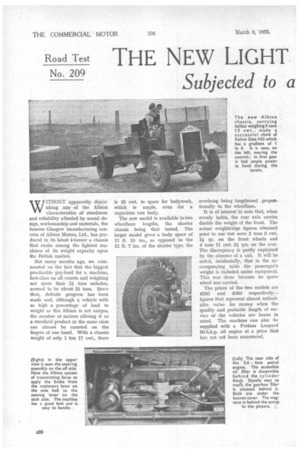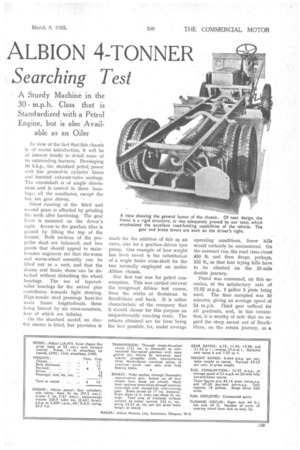THE NEW LIGHT
Page 50

Page 51

Page 52

If you've noticed an error in this article please click here to report it so we can fix it.
ALBION 4-TONNER
Subjected to a Searching Test
A Sturdy Machine in the 30 m.p.h. Class that is Standardized with a Petrol Engine, but is also Avail able as an Oiler
WITHOUT apparently dinainishing any of the Albion characteristics of sturdiness and reliability afforded by sound design, workmanship and materials, the famous Glasgow manufacturing concern of Albion Motors, Ltd., has produced in its latest 4-tormer a chassis that ranks among the lightest machines of its weight capacity upon the British market.
Not many months ago, we commented on the fad that the biggest practicable pay-load for a machine, first-class on all counts and weighing not more than 21 tons unladen, seemed to be about 31 tons. Since then, definite progress has been made and, although a vehicle with so high a percentage of load to weight as this Albion is not unique, the number of makers offering it as a standard product in the same class can almost be counted on the fingers of one hand. With a chassis weight of only 1 ton 17 cwt., there
is 13 cwt. to spare for bodywork, which is ample, even for a capacious van body.
The new model is available in two wheelbase lengths, the shorter chassis being that tested. The larger model gives a body space of 15 ft. 10 ins., as opposed to the 12 ft. 7 ins, of the shorter type, the
overhang being lengthened proportionally to the wheelbase.
It is of interest to note that, when evenly laden, the rear axle carries double the weight of the front. The actual weighbridge figures obtained prior to our test were 2 tons 3 cwt. 1i qr. on the front wheels and 4 tons 11 cwt. 31 qrs. on the rear. The discrepancy is partly explained by the absence of a cab. It will be noted, incidentally, that in the accompanying table the passenger's weight is included under equipment. This was done because no spare wheel was carried.
The prices of the two models are £395 and 400 respectively-figures that represent almost unbeatable value for money when the quality and probable length of service of the vehicles are borne in mind. The machine can also be supplied with a Perkins Leopard 60-b.h.p. oil engine at a price that has not yet been announced. In view of the fact that this chassis is of recent introduction, it will be of interest briefly to detail some of its outstanding features. Developing 60 b.h.p., the standard petrol_ power unit has pressed-in cylinder liners n rid inserted exhaust-valve seatings. The crankshaft is of ample dimensions and is carried in three bearings; all the auxiliaries, except the fan, are gear driven.
Silent running of the third and s(-cond gears is afforded by grinding the teeth after hardening. The gear lever is mounted on the driver's right. Access to the gearbox filler is gained by lifting the top of the bonnet. Both sections of the propeller shaft are balanced, and two points that should appeal to maintenance engineers are that the worm and worm-wheel assembly can be lifted out as a unit, and that the di' inns and brake shoes' can be detached without disturbing the wheel bearings. The use of taperedroller bearings for the swivel pins contributes towards light steering. High-tensile steel pressings form the main frame longitudinals, these being braced by six cross-members, four of which are tubular.
On the standard model, no electric starter is fitted, but provision is
made for the addition of this as an extra, also for a gearbox-driven tyre pump. One example of how weight has been saved is the substitution of a single brake cross-shaft for the two normally employed on earlier Albion chassis.
Our first test was for petrol consumption. This was carried out over the recognized Albion test course, from the Works at Scotstoun to Strathblane and back. It is rather characteristic of the company that it should choose for this purpose an unquestionably exacting route. The returns obtained are far from being the best possible, for, under average operating conditions, fewer hills would certainly be encountered. On the outward run, the road rises about 400 ft. and then drops, perhaps, 150 ft., so that four trying hills have to be climbed on the 20-mile double journey.
Petrol was consumed, on this occasion, at the satisfactory rate of 12.2 m.p.g., 1 gallon 5 pints being used. The time occupied was 50 minutes, giving an average speed of 24 m.p.h. Third gear sufficed for all gradients, and, in this connection, it is worthy of note that we regard the steep ascent out of Strathblame, on the return journey, as a
second-gear hill, and were surprised and impressed to find that it „we,s climbed in " third," despite its sharp bend. Those acquainted with the • district will appreciate this achieve ment.
A further hill-climbing trial was conducted on Kelvin .Dale, which is shown in an accompanying illustration. The gradient here is 1 in 6, and the Albion ascended it steadily in first gear at about 5 m.p.h. The behaviour of the vehicle when we tried a stop and start on this gradient led us to form the opinion that a slightly lower first gear would be desirable.
First Gear Rather High.
Although the restart was successfully accomplished, there was nothing to spare, and steeper hills than 1 in 6, admittedly rarely encountered, would, we think, be beyond its capabilities in this respect. The ratio is only 31.3 to 1. A 31tonner of well-known make and with an engine of slightly greater capacity, with which it seems fair to make comparison, has a first gear of 40 to 1.
As we pointed out, however, in our report of the performance of the Albion maximum-load fourwheeler on May 8 last, the policy of the company is not to regard "first " as just an emergency ratio, but as a gear in which it can climb any hill of not unreasonable steepness at an economic speed.
There is a lower axle ratio offered for this 4-tanner, and, for operation in really difficalt country, we would advise its employment.
First-class Brakes.
The -brakes are the best of any Albion we have tested, better than the average figure arrived at by plotting a curve for vehicles of all classes, and better than the average for the 4-ton class. Ferodo, Ltd., describes 60 per cent. efficiency (52 ft. from 30 m.p.h.) as "very good," The desirability of faster retardation than this for commercial vehicles is questionable.
The hand brake deserves a word of individual praise. The lever is well positioned for a powerful pull, and the brake is not merely a device for use when parking, but has an efficiency, in ordinary usage, of between 40 per cent. and 50 per cent.
In an accompanying graph, the acceleration figures we obtained are given. They speak for themselves. The machine has exceptional liveliness and flexibility, whilst the engine runs silently and smoothly up to a speed in excess of its legal limits c30 (30 m.p.h.) by a fair margin. Above this, however, some vibration and noise become apparent.
The maximum speed is not particularly high, but, what is of far greater importance, is that the vehicle can be driven fast over roads that could not be traversed so rapidly with safety on an inferior machine. The engine power is there, and Vie gears are appropriately selected to transmit it to the wheels, but it is' the road-holding powers which permit the most to be made of it.
A commercial vehicle with better fast-cornering properties we have rarely handled. Furthermore, the. steering steering is light and the gears are easy to change.
A Test for Suspension.
In front of the Albion works there is a road which, for potholes per square yard, must rank high. A portion of the "carriageway," too, incorporates a railway track. Accordingly, one does not need to travel far to test the suspension system.
It is, therefore, only natural that., special attention should be paid to Albion chassis in this respect. The ability to travel fast, without dist" comfort, over such a surface, and the cornering characteristics just re,ferred to, are inconsistent with un-' substantial chassis construction—in.,.. adequate springs or frames lacking rigidity.
We are confident that our tests' proved that weight saving in the manufacture of this new Albion chassis has in no way impaired those qualities with which its name has, for so many years, been closely associated. It is clear that it has not been allowed to interfere with the incorporation of improvements upon, previous designs.














































































































